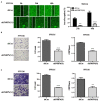Small Nuclear Ribonucleoprotein Polypeptide N Accelerates Malignant Progression and Poor Prognosis in Colorectal Cancer Transcriptionally Regulated by E2F8
- PMID: 33224876
- PMCID: PMC7669248
- DOI: 10.3389/fonc.2020.561287
Small Nuclear Ribonucleoprotein Polypeptide N Accelerates Malignant Progression and Poor Prognosis in Colorectal Cancer Transcriptionally Regulated by E2F8
Abstract
Colorectal cancer is a major cause of death worldwide, and the identification of new diagnostic and prognostic biomarkers is crucial to develop new strategies to avoid colorectal cancer-related deaths. Small nuclear ribonucleoprotein polypeptide N (SNRPN) is an imprinted gene that plays an important role in various neurodevelopmental disabilities. In this study, SNRPN was highly expressed in colorectal cancer tissues and involved in the progression of this disease. Immunohistochemistry analysis of 1,310 colorectal cancer tissue samples showed that SNRPN highly expressed in cancer tissues than in adjacent tissues and was mainly localized in the nucleus. Clinical pathological factor analysis demonstrated that higher expression of SNRPN was significantly associated with larger tumor size, location of the tumor on the left-sided colon, neural invasion, and distant metastasis. Univariate and multivariate analyses showed that SNRPN expression was an independent risk factor for survival, with high expression levels indicating worse overall survival. Both in vitro and in vivo experiments confirmed that high expression of SNRPN was associated with tumor proliferation, cell cycle, and metastasis. Knocking down SNRPN blocked the cell cycle at the G2/M phase transition and promoted tumor cell apoptosis, inhibiting the progression of colorectal cancer. To explore the up-steam of SNRPN, we found by luciferase reporter assay and chromosomal immunoprecipitation assay that E2F8 was a transcriptional regulator up-steam of SNRPN in colorectal cancer. Systematic studies of SNRPN will help us discover new regulatory molecules and provide a theoretical basis for finding new molecular targets for this disease.
Keywords: E2F8; SNRPN; colorectal cancer; metastasis; proliferation.
Copyright © 2020 Ji, Ren, Lv, Lao, Feng, Tang, Zhuang, Liu, Zheng and Xu.
Figures







Similar articles
-
Small nuclear ribonucleoprotein associated polypeptide N accelerates cell proliferation in pancreatic adenocarcinoma.Mol Med Rep. 2015 Oct;12(4):6060-4. doi: 10.3892/mmr.2015.4208. Epub 2015 Aug 11. Mol Med Rep. 2015. PMID: 26261020
-
Upregulation of E2F8 promotes cell proliferation and tumorigenicity in breast cancer by modulating G1/S phase transition.Oncotarget. 2016 Apr 26;7(17):23757-71. doi: 10.18632/oncotarget.8121. Oncotarget. 2016. PMID: 26992224 Free PMC article.
-
E2F8 confers cisplatin resistance to ER+ breast cancer cells via transcriptionally activating MASTL.Biomed Pharmacother. 2017 Aug;92:919-926. doi: 10.1016/j.biopha.2017.05.118. Epub 2017 Jun 8. Biomed Pharmacother. 2017. PMID: 28605876
-
Effect of small nuclear ribonucleoprotein-associated polypeptide N on the proliferation of medulloblastoma cells.Mol Med Rep. 2015 May;11(5):3337-43. doi: 10.3892/mmr.2015.3148. Epub 2015 Jan 7. Mol Med Rep. 2015. PMID: 25571951 Free PMC article.
-
Emerging role of E2F8 in human cancer.Biochim Biophys Acta Mol Basis Dis. 2023 Aug;1869(6):166745. doi: 10.1016/j.bbadis.2023.166745. Epub 2023 May 8. Biochim Biophys Acta Mol Basis Dis. 2023. PMID: 37164180 Review.
Cited by
-
N6-methyladenosine (m6A) RNA methylation regulator SNRPC is a prognostic biomarker and is correlated with immunotherapy in hepatocellular carcinoma.World J Surg Oncol. 2021 Aug 13;19(1):241. doi: 10.1186/s12957-021-02354-8. World J Surg Oncol. 2021. PMID: 34389000 Free PMC article.
-
An Update on the Potential Roles of E2F Family Members in Colorectal Cancer.Cancer Manag Res. 2021 Jul 9;13:5509-5521. doi: 10.2147/CMAR.S320193. eCollection 2021. Cancer Manag Res. 2021. PMID: 34276228 Free PMC article. Review.
-
Application of the Mass Spectrometry-High-Throughput Technique Over the Immunohistochemical Analysis for Human Brain Tumor Diagnosis and Prognosis: Insights Into Biomarkers' Identification for the Case Study of Grade IV Astrocytomas and Meningiomas.Biomed Chromatogr. 2025 Sep;39(9):e70170. doi: 10.1002/bmc.70170. Biomed Chromatogr. 2025. PMID: 40765374 Free PMC article.
-
Malignancies in Prader-Willi Syndrome: Results From a Large International Cohort and Literature Review.J Clin Endocrinol Metab. 2023 Nov 17;108(12):e1720-e1730. doi: 10.1210/clinem/dgad312. J Clin Endocrinol Metab. 2023. PMID: 37267430 Free PMC article. Review.
-
Altered methylation of imprinted genes in neuroblastoma: implications for prognostic refinement.J Transl Med. 2024 Aug 31;22(1):808. doi: 10.1186/s12967-024-05634-5. J Transl Med. 2024. PMID: 39217334 Free PMC article.
References
LinkOut - more resources
Full Text Sources

